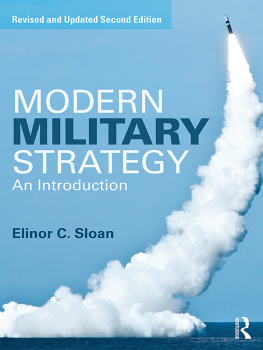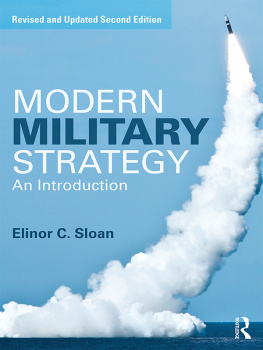War and Strategy in the Modern World
This volume brings together some of Professor Azar Gats most significant articles on the evolution of strategic doctrines and the transformation of war during the twentieth and early twenty-first centuries.
It sheds new light on the rise of the German Panzer arm and the doctrine of Blitzkrieg between the two world wars; explores the factors behind the formation of strategic policy and military doctrine in the world war era and during the Cold War; and explains why counterinsurgency has become such a problem. The book concludes with the spread of peace in the developed world, challenged as it is by the rise of the authoritarian-capitalist great powers China and Russia and by the chilling prospect of unconventional terrorism. This last chapter summarizes the authors latest research and has not previously been published in article form.
This collection will be of much interest to students of strategic studies, military history, and international relations.
Azar Gat is Ezer Weitzman Professor of National Security at Tel Aviv University. He is the author of eight books, including A History of Military Thought: From the Enlightenment to the Cold War (2001); War in Human Civilization (2006); Victorious and Vulnerable: Why Democracy Won in the 20th Century and How It Is Still Imperiled (2010); and The Causes of War and the Spread of Peace: But Will War Rebound? (2017). His books have been translated into Spanish, Japanese, Chinese, Korean, Greek, Turkish, and Hebrew.
Cass Military Studies
Transforming Warriors
The Ritual Organization of Military Force
Peter Haldn and Peter Jackson
Space Warfare in the 21st Century
Arming the Heavens
Joan Johnson-Freese
Strategy Before Clausewitz
Linking Warfare and Statecraft, 14001830
Beatrice Heuser
Special Operations Forces in the 21st Century
Perspectives from the Social Sciences
Jessica Glicken Turnley, Kobi Michael and Eyal Ben-Ari
Civilians and Warfare in World History
Nicola Foote and Nadya Williams
The Military and Liberal Society
Societal-Military Relations in Western Europe
Tomas Kucera
Israel, Strategic Culture and the Conflict with Hamas
Adaptation and Military Effectiveness
Niccol Petrelli
War and Strategy in the Modern World
From Blitzkrieg to Unconventional Terrorism
Azar Gat
For a full list of titles in this series, please visit www.routledge.com
First published 2018
by Routledge
2 Park Square, Milton Park, Abingdon, Oxon OX14 4RN
and by Routledge
711 Third Avenue, New York, NY 10017
Routledge is an imprint of the Taylor & Francis Group, an informa business
2018 Azar Gat
The right of Azar Gat to be identified as author of this work has been asserted by him in accordance with sections 77 and 78 of the Copyright, Designs and Patents Act 1988.
All rights reserved. No part of this book may be reprinted or reproduced or utilised in any form or by any electronic, mechanical, or other means, now known or hereafter invented, including photocopying and recording, or in any information storage or retrieval system, without permission in writing from the publishers.
Trademark notice: Product or corporate names may be trademarks or registered trademarks, and are used only for identification and explanation without intent to infringe.
British Library Cataloguing-in-Publication Data
A catalogue record for this book is available from the British Library
Library of Congress Cataloging-in-Publication Data
A catalog record for this book has been requested
ISBN: 978-1-138-63256-1 (hbk)
ISBN: 978-1-315-20815-2 (ebk)
Typeset in Times New Roman
by Apex CoVantage, LLC
This volume brings together a select collection of my articles on the evolution of strategic doctrines and the transformation of war during the twentieth and early twenty-first centuries. The articles are arranged in chronological order: the volume begins with the rise of the German Panzer arm and the doctrine of Blitzkrieg during the interwar period; it ends with the spread of peace in the developed world, threatened as it is by the challenge posed by the authoritarian-capitalist great powers China and Russia and by the chilling prospect of unconventional terrorism. The sequence of the articles also reflects the development of my interests and scholarly pursuits, starting with my books on the evolution of military theory and doctrine, assembled in the omnibus edition A History of Military Thought: From the Enlightenment to the Cold War (2000). My interests later expanded to broader questions relating to war, pursued in my War in Human Civilization (2006), Victorious and Vulnerable: Why Democracy Won in the 20th Century and How It is still Imperiled (2010), and The Causes of War and the Spread of Peace: But Will War Rebound? (2017).
In revising these articles for publication, I have tried not to make changes that would reflect the benefit of hindsight. Indeed, I have been satisfied to see that the articles have well withstood the test of time. Choosing to leave them basically in their original form has also meant that later publications on their respective subjects have not been included either. I do not find that they significantly alter my conclusions. Most of the changes I have introduced are cuts made to avoid repetitions and overlaps between the articles. I have also made occasional stylistic changes.
Misconceptions regarding the rise of the Panzer arm which gave Germany its lightning victories at the beginning of World War II are, surprisingly, very signifi-cant indeed. British Influence, the Evolution of the Panzer Arm, and the Rise of Blitzkrieg sets out to correct some of these major misconceptions. Revelations that the famous British military theorist B.H. Liddell Hart manipulated the German generals testimonies after World War II have discredited the claim of a decisive British influence on the evolution of the German Panzer arm during the 1920s and 1930s. However, the German archives from that period reveal that this influence was indeed paramount. The article also shows that fateful historical accidents, unnoticed by scholars, were largely responsible for the fact that the Panzer arm did not follow the mistaken routes taken by the other great powers with respect to the organization of armour. Finally, the article shows that, rather than being a formal doctrine formulated by the German armed forces during the 1930s, Blitzkrieg emerged as an operational concept only during the early campaigns of World War II, while the word itself was sensationally coined by the foreign press.
In the wake of World War II, the controversies of the interwar period regarding both national policy and strategic doctrine were dramatically viewed as struggles between prescience and folly. This narrative continues to dominate the popular view and the media. However, from the late 1960s, as national archives opened, scholars have been formulating a more complex and nuanced picture, in which right and wrong have not been as starkly contrasted as before. In Technology, National Policy, Ideology, and Strategic Doctrine between the World Wars, I outline the real dilemmas, deep constraints, genuine uncertainties, and conflicting goals which haunted governments and military establishments during the 1930s.











